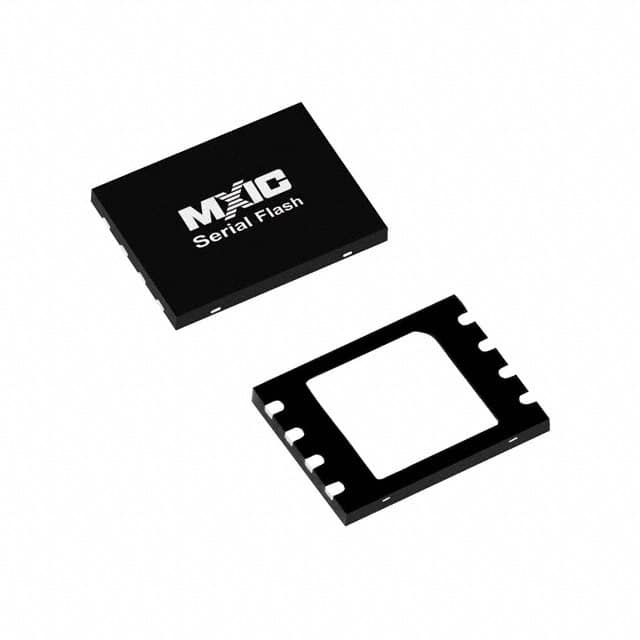MX25L6406EZNI-12G
Product Overview
Category
The MX25L6406EZNI-12G belongs to the category of non-volatile memory products.
Use
It is primarily used for storing data in electronic devices, such as computers, smartphones, and other consumer electronics.
Characteristics
- Non-volatile: The MX25L6406EZNI-12G retains stored data even when power is removed.
- High capacity: It has a storage capacity of 64 megabits (8 megabytes).
- Fast read/write speeds: The device offers high-speed data transfer rates for efficient data access.
- Low power consumption: It operates with low power requirements, making it suitable for battery-powered devices.
Package
The MX25L6406EZNI-12G is available in a compact surface-mount package.
Essence
This product is an essential component for data storage in various electronic devices, enabling reliable and efficient data management.
Packaging/Quantity
The MX25L6406EZNI-12G is typically packaged in reels or trays, with a quantity of 2500 units per reel/tray.
Specifications
- Memory Type: Serial Flash
- Capacity: 64 Megabits (8 Megabytes)
- Interface: SPI (Serial Peripheral Interface)
- Operating Voltage: 2.7V - 3.6V
- Operating Temperature Range: -40°C to +85°C
- Data Retention: Up to 20 years
- Erase/Program Cycles: 100,000 cycles
Detailed Pin Configuration
The MX25L6406EZNI-12G features a standard pin configuration with the following pins:
- Chip Select (/CS)
- Serial Clock (SCLK)
- Serial Data Input (SI)
- Serial Data Output (SO)
- Write Protect (/WP)
- Hold (/HOLD)
- VCC (Power Supply)
- Ground (GND)
Functional Features
- High-speed data transfer: The MX25L6406EZNI-12G offers fast read and write speeds, allowing for efficient data access.
- Flexible interface: It utilizes the Serial Peripheral Interface (SPI) for easy integration with various microcontrollers and systems.
- Sector-based erase/write: The device supports sector-based operations, enabling targeted modification of specific data segments.
- Write protection: The /WP pin allows for hardware-based write protection, preventing accidental data modification.
Advantages and Disadvantages
Advantages
- High storage capacity
- Fast data transfer rates
- Low power consumption
- Long data retention period
- Compact package size
Disadvantages
- Limited erase/program cycles
- Requires external microcontroller or system for operation
Working Principles
The MX25L6406EZNI-12G operates based on the principles of flash memory technology. It utilizes a grid of memory cells that can be electrically programmed and erased. Data is stored in these cells by applying electrical charges to specific locations within the memory array. The stored data can be accessed and modified through the SPI interface.
Detailed Application Field Plans
The MX25L6406EZNI-12G finds applications in various electronic devices, including but not limited to: - Computers and laptops - Smartphones and tablets - Digital cameras - Gaming consoles - Automotive electronics - Industrial control systems
Detailed and Complete Alternative Models
Some alternative models to the MX25L6406EZNI-12G include: - MX25L3206EZNI-12G: 32 Megabit Serial Flash Memory - MX25L12835FZNI-10G: 128 Megabit Serial Flash Memory - MX25L25673GZNI-10G: 256 Megabit Serial Flash Memory - MX25L51245GZNI-10G: 512 Megabit Serial Flash Memory
These alternative models offer different storage capacities to suit specific application requirements.
Word count: 520 words
Lista 10 Vanliga frågor och svar relaterade till tillämpningen av MX25L6406EZNI-12G i tekniska lösningar
Sure! Here are 10 common questions and answers related to the application of MX25L6406EZNI-12G in technical solutions:
Q: What is MX25L6406EZNI-12G? A: MX25L6406EZNI-12G is a serial NOR flash memory chip manufactured by Macronix. It has a capacity of 64 megabits (8 megabytes) and operates at a voltage range of 2.7V to 3.6V.
Q: What are the typical applications of MX25L6406EZNI-12G? A: MX25L6406EZNI-12G is commonly used in various electronic devices such as routers, set-top boxes, digital cameras, printers, and automotive systems for storing firmware, configuration data, and other non-volatile information.
Q: What is the interface used to communicate with MX25L6406EZNI-12G? A: MX25L6406EZNI-12G uses a standard Serial Peripheral Interface (SPI) for communication. It supports both single and dual SPI modes.
Q: What is the maximum operating frequency of MX25L6406EZNI-12G? A: MX25L6406EZNI-12G can operate at a maximum frequency of 104 MHz in single SPI mode and 80 MHz in dual SPI mode.
Q: Can MX25L6406EZNI-12G be easily soldered onto a PCB? A: Yes, MX25L6406EZNI-12G comes in an industry-standard 8-pin SOIC package, which can be easily soldered onto a PCB using conventional surface mount technology.
Q: Does MX25L6406EZNI-12G support hardware write protection? A: Yes, MX25L6406EZNI-12G provides hardware write protection through a Write Protect (WP#) pin. When WP# is pulled low, it prevents any write operations to the memory.
Q: What is the typical erase and program time for MX25L6406EZNI-12G? A: The typical sector erase time for MX25L6406EZNI-12G is around 100 milliseconds, while the typical page program time is around 0.5 milliseconds.
Q: Can MX25L6406EZNI-12G operate in extreme temperature conditions? A: Yes, MX25L6406EZNI-12G has an extended operating temperature range of -40°C to +85°C, making it suitable for applications in harsh environments.
Q: Does MX25L6406EZNI-12G support software and hardware reset functions? A: Yes, MX25L6406EZNI-12G supports both software reset (using specific commands) and hardware reset (by toggling the Reset# pin).
Q: Is MX25L6406EZNI-12G backward compatible with previous generations of MX25L flash memory chips? A: Yes, MX25L6406EZNI-12G is fully backward compatible with previous generations of MX25L flash memory chips, ensuring easy migration for existing designs.
Please note that these answers are general and may vary depending on the specific implementation and requirements of your technical solution.


